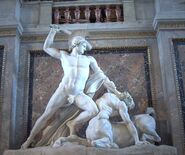No edit summary Tag: Visual edit |
mNo edit summary |
||
| Line 10: | Line 10: | ||
|greekmythologywiki= |
|greekmythologywiki= |
||
|caption = Like a boss}} |
|caption = Like a boss}} |
||
| − | The '''centaurs''' (also kwown as Ixionidae) are a race of creatures |
+ | The '''centaurs''' (also kwown as Ixionidae) are a race of creatures that are part human and part horse. Their first appearance comes from early Greek archaeological finds in which Attic vase-paintings depicted the centaurs as the torso of a human joined at the waist to the horse's withers, where the horse's neck would be. |
The centaurs were spawned by the cloud nymph [[Nephele ]] who was raped by the impious [[Lapiths|Lapith ]] King [[Ixion]], which is the cause of the Centaurs [[Centauromachy|hatred for the Lapiths]]. |
The centaurs were spawned by the cloud nymph [[Nephele ]] who was raped by the impious [[Lapiths|Lapith ]] King [[Ixion]], which is the cause of the Centaurs [[Centauromachy|hatred for the Lapiths]]. |
||
| Line 17: | Line 17: | ||
[[File:12.jpg|thumb]] |
[[File:12.jpg|thumb]] |
||
| − | |||
== In Mythology == |
== In Mythology == |
||
Revision as of 11:40, 29 March 2014
The centaurs (also kwown as Ixionidae) are a race of creatures that are part human and part horse. Their first appearance comes from early Greek archaeological finds in which Attic vase-paintings depicted the centaurs as the torso of a human joined at the waist to the horse's withers, where the horse's neck would be.
The centaurs were spawned by the cloud nymph Nephele who was raped by the impious Lapith King Ixion, which is the cause of the Centaurs hatred for the Lapiths.
They inhabited the mountains and forests of Magnesia. They lived in mountain caves, hunted wild animals for food and armed themselves with rocks, tree branches and later built weapons of their own.
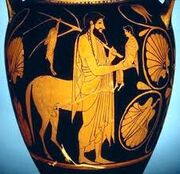
In Mythology
Centaurs are thought of in many Greek myths as wild as untamed horses. Like the Titanomachy, the defeat of the Titans by the Olympian gods, the contests with the centaurs typify the struggle between civilization and barbarism.
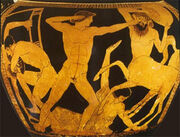
Theseus vs the Centaurs
The centaurs are best known for their fight with the Lapithae, caused by their attempt to carry off Hippodamia and the rest of the Lapith women, on the day of her marriage to Pirithous, king of the Lapithae, himself the son of Ixion. The strife among these cousins is a metaphor for the conflict between the lower appetites and civilized behavior in humankind. Theseus, a hero and founder of cities, who happened to be present, threw the balance in favor of the right order of things, and assisted Pirithous. The centaurs were driven off or destroyed.
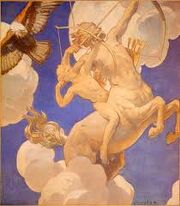
Another Lapith hero, Caeneus, who was invulnerable to weapons, was beaten into the earth by centaurs wielding rocks and the branches of trees. Their habitat is land like valleys, prairies, etc.
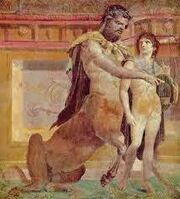
Other centaurs
One ancient writer also mentions a tribe of bull-horned Centaurs native to the island of Kypros.
Known Centaurs
| Latin spelling | Transliteration | Greek name | Description |
|---|---|---|---|
| Asbolus | Asbolos | Ασβολος | Asbolus (English translation: "sooty" or according to Dieter Koch, "carbon dust") was a diviner who read omens in the flight of birds. |
| Chariclo | Was the wife of the Centaur Chiron. | ||
| Chiron | He was the eldest and wisest of the Centaurs and also the ancient Trainer of Heroes. | ||
| Eurytion | Eurytiôn | Ευρυτιων | Eurytion was the name of two centaurs.
|
| Amycus | (Greek: Ἄμυκος) was the son of Ophion and attended Pirithous's wedding. He fought against Theseus and the Lapiths. He was killed by Pelates. The minor planet 55576 Amycus is named after this centaur. | ||
| Bienor | Biênôr | Βιηνωρ | Another of the centaurs that assisted Peirithous wedding. He was killed by Theseus.[1] |
| Centaurus | The father of the centaur race and friend of the Argonauts. The constellation Centaurus is named after this centaur. | ||
| Cyllarus | Kyllaros | Κυλλαρος | Translation: Crooked-, Bandy-
Legged (kyllos) . He was one of the centaurs to assist the wedding of king Perithious. He aided his fellow centaurs in the battle against the lapiths. He was severly wounded by a spear, subsequently dying in his wife's arms. |
| Hylonome | Hylonomê | Ὑλονομη | Translation: Woodland Pasture
(hylê, nomos). Female centaur and the wife of Cyllarus. She took her life after Cyllarus died to join him in the afterlife. |
| Rhaecus | He and Hylaeus tried to rape Atalanta. He was also killed by Meleager. | ||
| Dictys | Diktys | Δικτυς | (Translated to Of the Hunting Net (diktyon) ). He was one of the centaurs to assist Pirithous' wedding. He aided his fellow centaurs in the battle against the Lapiths. He escaped from Pirithous grasp, but slipped and fell off a cliff impaling himself on the top of an ash tree, causing his own death.[2] |
| Ichthyocentaurs | Pair of Centaur-related sea gods. They were half-brothers of Chiron and sons of Poseidon and Amphitrite. | ||
| Kentaurides | Female members of the Centaur tribe Kentauroi. | ||
| Nessus | Nessos | Νεσσος | (Translated to Duck ? (nêssa)), he was a Centaur that fought in the battle against the Lapiths and survived. |
| Perimedes | Perimêdês | Περιμηδης | A son of Peuceus, who attended Pirithous's wedding and fought against the Lapiths.[3] |
| Pholus | Wise centaur and friend of Heracles. | ||
| Eurytus | Eurytos | Ευρυτος | Name for any of the two centaurs known as Eurytion. |
| Hylaeus |
He and Rhaecus tried to rape Atalanta. He was killed by Meleager. | ||
| Petraeus | Petraios | Πετραιος | |
| Arctus | Arktos | Αρκτος | |
| Ureus | Oureios | Ουρειος | |
| Mimas | Mimas | Μιμας | |
| Peuceus | Peukeus | Πευκευς | |
| Dryalus | Dryalos | Δρυαλος | |
| Amycus | Amykos | Αμυκος | |
| Gyrneus | Gyrneus | Γυρνευς | (Possibly meaning Run-in-Circles (gyreuô)) |
| Rhoetus | Rhoitos | Ροιτος | (Translation: Pomegranate-Wine? (rhoitês)) |
| Orneus | |||
| Lycabas | |||
| Medon | |||
| Thaumas | |||
| Pisenor | |||
| Melaneus | |||
| Phobas | |||
| Abas | |||
| Astylus | |||
| Lycidas | |||
| Areus | |||
| Imbreus | |||
| Eurynomus | |||
| Crenaeus | |||
| Aphidas | |||
| Lycas | |||
| Chromis | |||
| Helops | |||
| Aphareus | |||
| Nedymnus | |||
| Lycopes | |||
| Hippasus | |||
| Ripheus | |||
| Thereus | |||
| Demeleon | |||
| Phlegraeus | |||
| Hyles | |||
| Iphinous | |||
| Clanis | |||
| Dolyas | |||
| Phaeocomes | |||
| Teleboas | |||
| Chthonius | |||
| Pyretus | |||
| Echeclus | |||
| Erigdupus | |||
| Antimachus | |||
| Pyraemon | |||
| Bromus | |||
| Elymus | |||
| Styphelus | |||
| Latreus | |||
| Monychus | |||
In Popular Culture
Media and Literature

Glenstorm from The Chronicles of Narnia: Prince Caspian movie.
Centaurs frequently appear in fantasy novels, movies, and video games. Notable appearances include:
- Heroes of Might and Magic (video game series)
- The Chronicles of Narnia (book and movie series)
- World of Warcraft (video game)
- Harry Potter (book and film series)
- God of War (video game series)
Video games
- The Centaurs appear in the side-scroling video game The Battle of Olympus.
Notes
- From greek myth, Theseus is the figure who has slayed more centaurs than anyone else, at least by himself.
Related articles
References
External links
- Centaurs article at Theoi.
Gallery



